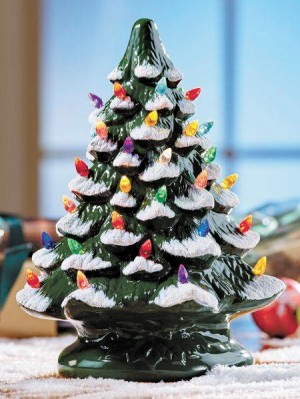In the last half of the 1960’s literally thousands ceramics shops sprung up across the US. For many it became a family affair, enabling young and old alike to mold a hunk of clay into a piece of “art.” Banks, ashtrays, coffee mugs were produced by the thousand, but perhaps the most popular (and lasting) of these grassroots creations was…the Christmas Tree.
As the popularity of ceramics as a craft grew, the factories that manufactured supplies entered the marketplace with ceramic trees of their own. The average height of these commercially produced trees was 17-24 inches and they were produced, not only in green, but white, yellow, red and even pink. You will find an abundance of these trees manufactured from 1960-1980. The problem is, you will also find a lot of modern reproduction.
If you have your heart set on a truly “vintage” tree, there are several things to watch for.
Early trees had tiny little lights that lit individually. As we moved into the later part of the 1970s that changed over to one light bulb that was inserted into the tree to light small plastic “bulbs” in a variety of primary colors. Take a close look at the bulbs on the tree you are considering. Older trees will have glass bulbs, while the newer ones will have plastic.
Dates on the bottom of the tree can be misleading. A tree may be marked 1972, the date the mold was first issued, when it was actually manufactured in 2005. Factory produced trees will sometimes have a model number on the bottom which you can research along with the factory name to determine age, and craft trees are often crudely incised with the date that they were fired.
Research into the major manufacturers of ceramic trees can also help you to establish age. Atlantic Mold led the way for U.S. production dating back to the late 50s. Other companies of note include Dogwood Ceramic Supply, Arnel’s and Holland Mold.
It is not uncommon for trees before 1980 to have sustained minor flaws or even to be missing their base or colored “bulbs.” The best source I have found for missing parts is through amazon.com. They offer a wide selection, good pricing and speedy delivery. As to repairs, if it is minor I would overlook it. If the damage is extensive enough to merit attention, check with an experienced clerk at your local craft store for advice on the proper paint for touch up. If a tree has electrical problems, I would pass. Better to be safe than to deal with a fire hazard.
Interest in ceramics as a hobby declined sharply as we entered the 1990s, forcing mold companies and ceramic shops began to close and causing many of the original molds to be destroyed. From the mid-1990s on the bulk of ceramic trees offered for sale in the U.S. were imported from Japan and later China.
COLLECTORS NOTE: Most of the vintage trees you will find are from the late 1960s through the late 1970s. However, there are two exceptions that are difficult to find and quite valuable. These are the ceramic trees made in the late 1940s by private craftsmen and the first commercially designed trees issued in 1958 by Atlantic Molds. These are rare and will be at the top of the price range.
Linda Kennett is a profession liquidation consultant specializing in senior downsizing and the liquidation of estates and may be reached at 317-258-7835 or lkennett@indy.rr.com



